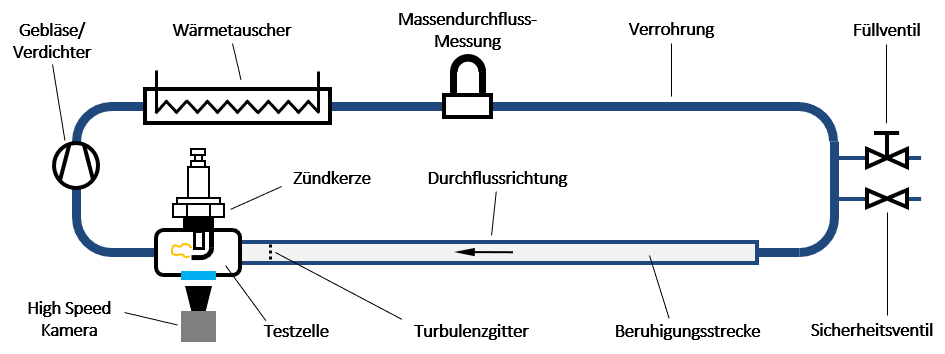Measurements for validation of ignition models
To support the development and validation of the ignition model, both basic experiments with a special ignition test bench and tests with real application scenarios on the single-cylinder research engine are planned.
The ignition test rig was designed and built according to the following principle in order to be able to investigate the spark behavior, which is of fundamental importance for the initiation of ignition, under a wide range of reproducible boundary conditions such as pressure, temperature, flow velocity and ignition system settings.

Figure 1: Schematic of the ignition test bench
In order to evaluate the influences of the above-mentioned boundary conditions on the spark behavior, images were taken with a high-speed camera and the high temporal resolution current and voltage signals of the ignition system were recorded using an oscilloscope. The figure below shows a comparison of the first 250µs of the spark behavior at ambient conditions without flow (a) and at increased pressure and defined flow (b) in the form of an image sequence with a capture rate of 120,000 frames/s and an exposure time of 1.25 µs (every eighth frame is shown).

Figure 2: Ignition process at ambient conditions (a) and at increased pressure and defined flow (b).
As a result of the flow and increased pressure, there is a later sparkover and a clear spark drift. The stronger light intensity in case (b) can be equated with an increase in the energy supplied to the spark.
The measurement technique also made it possible to investigate burning duration, spark formation, breakdown location, etc., with a higher level of detail. Furthermore, the test rig enables the temporally high-resolution optical recording of phenomena that have not been investigated in detail in this form so far (e.g. particle ejection from the electrode material).
For further verification of the developed models, additional measurements of the ignition process on a single-cylinder research engine are planned for the coming year in accordance with a measurement program optimized for model verification.